Visit to Bermuda
by Peter Vanderwaart pvanderw@optonline.net
|
| In June of 2000, my father took about 20 of his closest relatives on a cruise
to Bermuda. I took along a new digital camera and took as many pictures of boats as I
could. For family and personal reasons, I didn't get around the island very much, but I
did see a few things of interest Bermuda is of volcanic origin. It is
the long, thin, erratically shaped edge of a very extinct volcano that has eroded nearly
back to sea level. The island is not very wide anywhere, and it encloses several large
bays. The sea around the island is shoal for miles out to sea. As a result, Bermuda is
primarily a small boat sailing venue despite its oceanic location. Of course, it is used
as a waypoint for boats making ocean crossings, especially from northern New England and
Canada to the West Indies, and from the southern United States to Europe.
Our visit coincided with the end of the Newport-Bermuda Yacht
Race. Looking from the bow of our ship, the Nordic Empress, as she was tied up at
Hamilton, we could see the racing fleet tied up at the Royal Bermuda Yacht Club. It is the
pink building closer to the boats. I was able to walk the docks and take some pictures of
the boats, but I found the fleet somewhat uninteresting as it was mostly composed of the
same J-boats and Farr designs that I see at home on Long Island Sound.
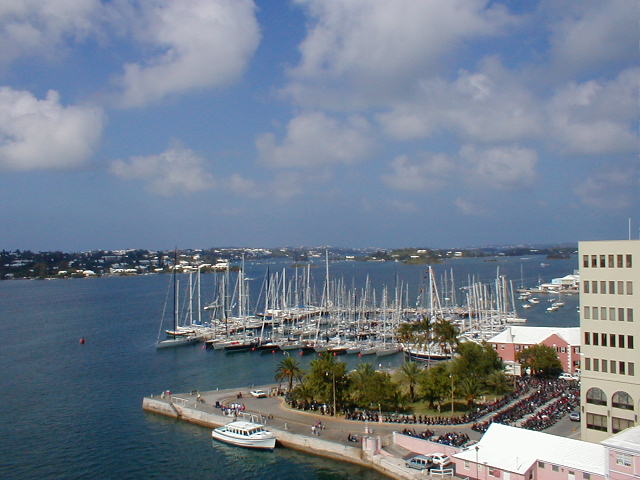
|
| An exception was Kirawan, the 1936 winner, recently restored to perfect
condition. One member of the crew that raced her to Bermuda was John Rousmaniere, the
well-known writer of "Fastnet Force 10" and "The Annapolis Book of
Seamanship." This shot gives a better view of the yacht club, the pink building in
the background. 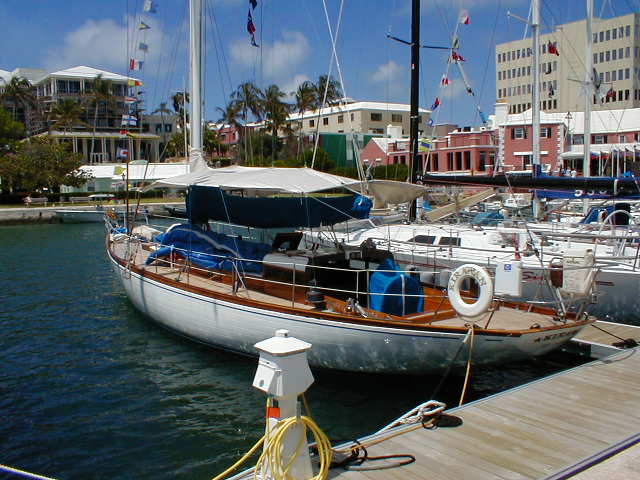
|
| For half of our stay, the cruise ship was tied up in King's Wharf, formerly
the site of a Royal Navy base, and now given over to tourist attractions. The next picture
approximates the view from our stateroom window in the evening. The pink catamaran is a
cylinder-molded Kurt Hughes design named Restless Native. It does tourist sail/scuba duty,
and my children and I spent a half-day aboard. It's a perfect boat for the service.
Captain Kirk (true!) had us doing 9 1/2 Kts upwind, sailing essentially single-handed. The
Bermuda Marine Museum is to the right, and includes the former Commandant's house perched
on the hill.
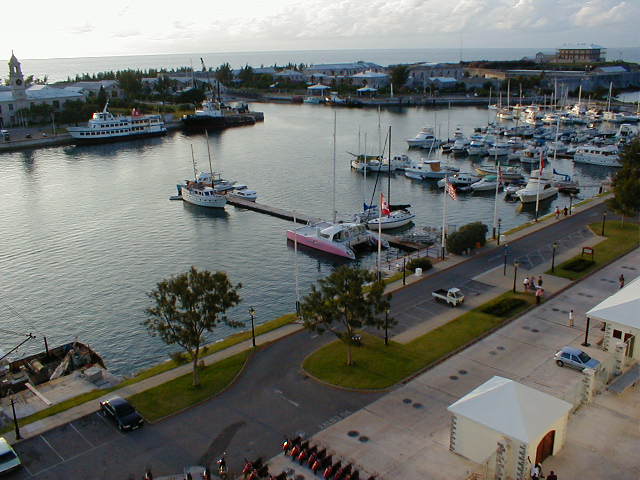
|
| One of the museum buildings is devoted to the display of some small boats.
There are several Bermuda Fitted Dinghies, a 15' racing class from about 100 years ago. I
understand that "fitted" means "with a keel." They were wonderfully
designed and built. It may be some indication of the standard that one of the boats on
display was by N. G. Herreshoff, the Wizard of Bristol. I didn't make a note of who built
this one. 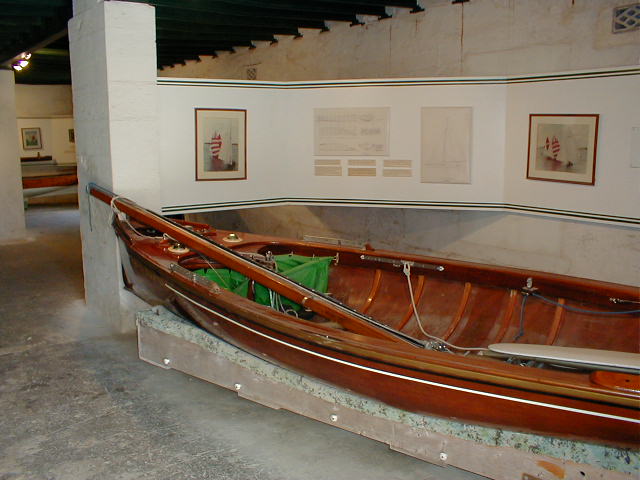
|
| This is a completely rigged boat, which sits over a hole in the floor that
accommodates the keel. You can get an idea of the generous proportions of the rig. On the
right is a model. You can see that the keel has a rectangular profile, as was usual in the
full size boats. The boats flew the old-fashioned kind of triangular spinnaker. The
pictures indicated that the inboard end of the spinnaker pole was held by a crew member,
which seems to me to carry some potential for occasional excitement. 
|
| There were only a couple of working boats on display. One was this turtle
fishing boat. As you can see, the exhibit describes the turtle fishery. 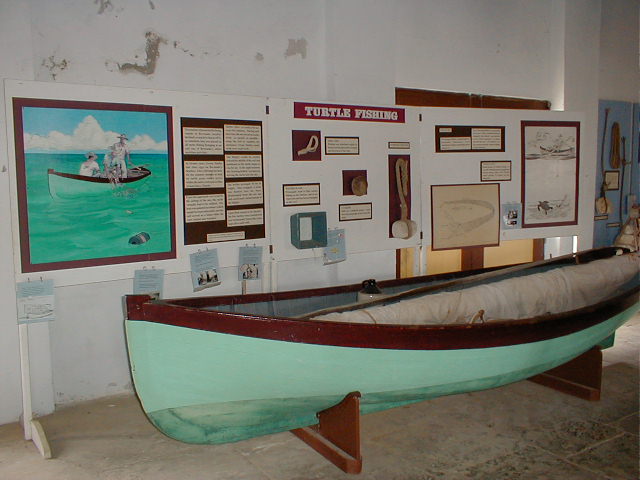
|
| The final boat from the museum is a little cruiser named Spirit of Bermuda. It
is a double-ended, hard chine sloop about 16' long. It was sailed from Bermuda to New York
by two brothers. The trip took 17 days. The boat has a keel about 10 inches deep. The
cabin had a canvas cover. I believe that she is built of Bermuda cedar. This is locally
considered to be an excellent boat-building wood, which is especially convenient because
it is also about the only locally-grown wood available. In the past, it was used for
building sizeable craft, up to ocean crossing sailing ships. 
|
| This boat was in the marina at King's Wharf. I believe that it is a Tahiti
ketch, to John Hanna's original design, although I'm really just guessing. It is always
interesting to come across a boat built to one of the famous old designs. It gives the
chance to compare the impression given by looking at the plans and pictures to the real
thing. That's the Nordic Empress in the background.
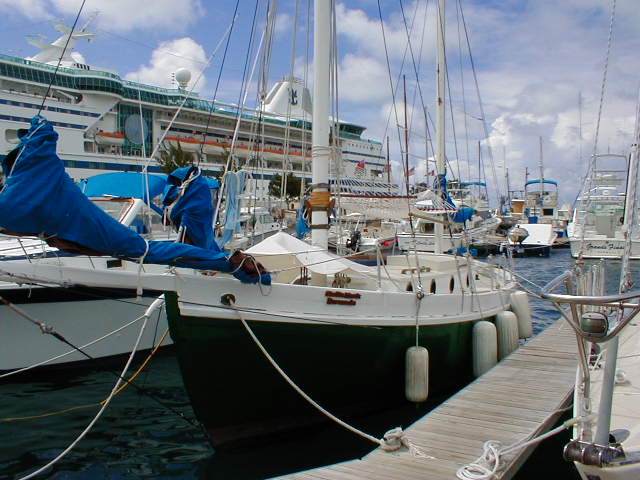
|
| The final picture is of a racing class called the International One Design or
IOD. I saw a dozen or so IOD's in Hamilton harbor, but I didn't get a picture so I got
permission from www.iodclass.com to use one of
theirs. The class was designed by Bjarne Aas. It is somewhat like the International
Dragon. In his book "Sailing Boats," Uffa Fox described it as a refined IYRU 6
meter. They are 33' 4" overall and 21' 6" on the water, displacing just shy of
7000 lbs. These boats have been used for prestigious races in Bermuda
through the years and there are pictures of them are in many books on racing.
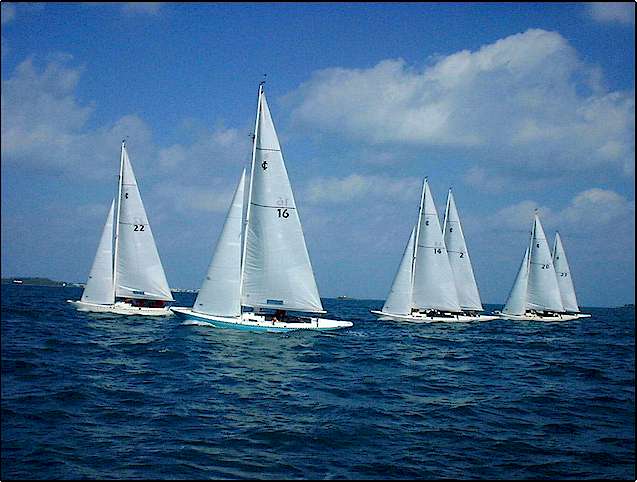
|
| And those are the boats I saw on my summer vacation. |

Note: These pictures were taken with
an Olympus
D-360L digital camera and are all original size and un-retouched. The camera records
on SmartMedia cards. The 8MB card that comes with the camera will hold 122 pictures at the
standard quality size of 640 x 480 pixels. It is possible to take pictures up to 1280x960,
which is sometimes convenient (e.g. for computer wallpaper), but the picture quality is
not a whole better because of hand shake and, possibly, the limitations of the lens.
Power is supplied by 4 AA cells which will last for hundreds of pictures if you avoid
using the LCD screen and use a power adapter for downloading to the computer.
Downsides: The focal length of the lens is chosen for ordinary snapshots which are usually
groups of people, so it is too wide angle to be ideal for boats. In common with most
digital cameras, it exaggerates contrast making shaded areas darker than you want them. |

|